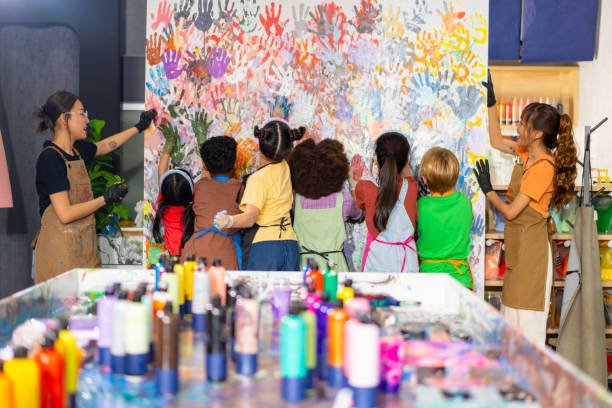Visual arts have long been recognized as a form of communication, offering people an avenue to express feelings and ideas that might be difficult to articulate through words. In educational settings, visual arts education provides students with tools not just for artistic expression but also for emotional expression and processing. Art-making helps students to explore their emotions, work through personal challenges, and develop emotional intelligence. This essay will explore how visual arts education plays a significant role in fostering emotional expression, focusing on various aspects including creativity, therapeutic benefits, emotional intelligence, identity exploration, and social-emotional learning.
The Role of Creativity in Emotional Expression
Visual arts education is deeply intertwined with creativity, which is one of the key drivers of emotional expression. Creativity allows individuals to convey thoughts and feelings that may not be easily communicated through spoken or written language. This is particularly important for children and adolescents, whose emotional vocabulary may still be developing. Through visual arts education, students are encouraged to think outside the box and use materials, colors, shapes, and textures to represent emotions like joy, sadness, anger, or fear.
The process of creating art enables students to access their subconscious thoughts and feelings. For example, a student might express a deep sense of sadness through the use of dark colors in a painting, even if they are unable to verbally articulate that emotion. In this way, visual arts education offers a safe space for emotional release and exploration.
Art as a Therapeutic Outlet
In addition to fostering creativity, visual arts education serves as a therapeutic outlet for emotional expression. Many art therapists use various forms of art to help individuals process trauma, stress, anxiety, and other emotional challenges. While art therapy is a specialized practice, many of its principles can be applied in visual arts education to support students in expressing and processing their emotions.
Creating art can be an inherently calming activity, allowing individuals to channel their energy and focus into a productive task. This meditative process can help to reduce feelings of stress or anxiety, making it an effective tool for students who may struggle with emotional regulation. Moreover, the non-verbal nature of art allows students to express emotions that they may find difficult or uncomfortable to talk about.
For example, a student dealing with grief might not feel ready or able to discuss their feelings with a teacher or counselor. However, through visual arts education, they can create drawings, paintings, or sculptures that reflect their emotional state. This act of creation helps the individual to process their emotions and gain insight into their feelings.
Developing Emotional Intelligence Through Visual Arts Education
Another critical way that visual arts education supports emotional expression is by helping students develop emotional intelligence. Emotional intelligence refers to the ability to recognize, understand, and manage one’s own emotions, as well as the emotions of others. This skill is essential for building healthy relationships, making responsible decisions, and managing stress.
In a visual arts education setting, students are encouraged to reflect on their own emotions and those of others. They may be asked to consider how certain colors, forms, or compositions can evoke particular feelings. By engaging with art in this way, students develop a greater awareness of their emotions and learn how to express them effectively.
Moreover, visual arts education often involves collaboration and critique, where students must consider the perspectives and emotions of their peers. This helps to foster empathy and social awareness, key components of emotional intelligence. Through the process of creating and discussing art, students learn how to communicate their emotions more effectively and build emotional resilience.
Identity Exploration and Self-Expression
One of the most profound ways in which visual arts education supports emotional expression is through identity exploration. Adolescence, in particular, is a time when individuals are grappling with questions of identity—Who am I? What are my values? What is my place in the world? Visual arts education offers a powerful medium for students to explore these questions and express their evolving sense of self.
In many cases, students may use art as a way to reflect on their personal experiences, cultural background, and emotional journey. For example, a student might create a series of self-portraits that explore different aspects of their personality or identity. This process of self-expression allows students to articulate emotions and thoughts that they may not have fully understood or recognized before.
Moreover, visual arts education provides a non-judgmental space where students can experiment with different ideas and ways of expressing themselves. This freedom to explore and create fosters a sense of autonomy and self-confidence, which can have a positive impact on emotional well-being.
Social-Emotional Learning and Visual Arts Education
Visual arts education also supports social-emotional learning (SEL), an educational approach that focuses on developing students’ social and emotional skills. SEL programs often include components like self-awareness, self-management, social awareness, relationship skills, and responsible decision-making. These skills are critical for emotional well-being and success in life.
Incorporating visual arts education into SEL programs can enhance the emotional learning experience for students. Art projects can be designed to encourage self-reflection, emotional expression, and empathy. For instance, a project that asks students to create art based on a specific emotion (such as anger or happiness) encourages them to reflect on their own emotional experiences while also fostering a greater understanding of how others may feel.
Additionally, visual arts education often involves group projects or collaborative work, which helps to build relationship skills and social awareness. Working together on a shared creative task encourages students to communicate, negotiate, and empathize with one another—skills that are essential for building emotional intelligence.
Visual Arts and Mental Health
Numerous studies have shown that engaging in visual arts education can have a positive impact on mental health. Art-making has been found to reduce symptoms of anxiety, depression, and post-traumatic stress disorder (PTSD) in both children and adults. The act of creating art allows individuals to process difficult emotions and experiences in a safe and constructive way.
In an educational setting, visual arts education can provide students with a healthy outlet for managing stress and emotional challenges. Whether it’s through painting, drawing, sculpture, or other forms of art, students have the opportunity to express their emotions in a way that feels safe and manageable. This can be particularly beneficial for students who may be dealing with mental health challenges or difficult life circumstances.
For example, a student who is experiencing anxiety may find relief in the repetitive motions of drawing or coloring. The act of focusing on a creative task can help to quiet the mind and reduce feelings of anxiety. Over time, visual arts education can help students to develop coping strategies for managing their emotions in healthy ways.
Art as a Form of Communication
For many students, art serves as a vital form of communication, especially when words fail to capture the complexity of their emotions. This is particularly true for students with disabilities, such as those on the autism spectrum, who may struggle with verbal communication. Visual arts education provides these students with a means of expressing their thoughts and emotions in a way that feels more natural and accessible.
In this context, art becomes a powerful tool for self-expression and emotional communication. A student who may not be able to articulate their feelings through language can still convey a deep emotional message through their artwork. This form of non-verbal communication can be incredibly empowering, giving students a voice and a sense of agency in their emotional lives.
Moreover, visual arts education can help to bridge communication gaps between students and teachers or peers. By viewing and discussing each other’s artwork, students and educators can gain valuable insights into each other’s emotional experiences. This can lead to more meaningful connections and a greater sense of empathy within the classroom.
The Role of Teachers in Supporting Emotional Expression Through Visual Arts
Teachers play a critical role in supporting emotional expression through visual arts education. By creating a safe and supportive environment, teachers can encourage students to take creative risks and explore their emotions through art. This requires a balance of guidance and freedom, as students need both structure and autonomy to fully engage in the emotional aspects of art-making.
Teachers can also help students to reflect on their emotional experiences and the emotions they see in others’ artwork. By asking open-ended questions and facilitating discussions, educators can foster a deeper understanding of how emotions are expressed and experienced through art. This reflective process is key to helping students develop emotional intelligence and self-awareness.
Moreover, teachers can use visual arts education as a tool for addressing specific emotional or social challenges within the classroom. For instance, if a class is dealing with issues of bullying or conflict, a teacher might design an art project that encourages students to reflect on their emotions and experiences related to these issues. This can help to foster empathy and emotional understanding among students, creating a more supportive and inclusive classroom environment.
Conclusion
Visual arts education offers a powerful and multifaceted way to support emotional expression. Through creativity, therapeutic outlets, emotional intelligence development, identity exploration, and social-emotional learning, students gain valuable tools for understanding and expressing their emotions. Art provides a safe and non-verbal medium for students to process their feelings, communicate with others, and build emotional resilience. As a result, visual arts education is not only essential for artistic development but also for emotional well-being and personal growth.




